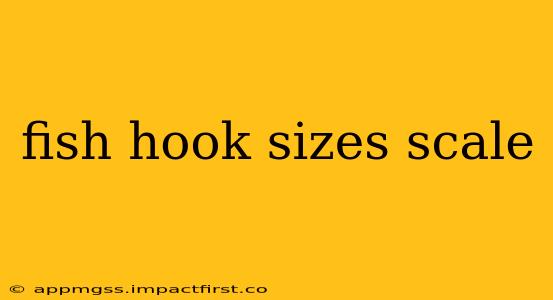Choosing the right fish hook size is crucial for successful fishing. A hook that's too small will easily pull free, while one that's too large can scare fish away or make hooking difficult. Understanding the hook size scale and its implications is vital for anglers of all skill levels. This guide will break down the intricacies of fish hook size scaling, helping you select the perfect hook for your target species and fishing conditions.
What is the Fish Hook Size Scale?
Fish hook sizes are measured using a numbering system, where smaller numbers indicate larger hooks and larger numbers indicate smaller hooks. This seemingly counterintuitive system originated historically and is consistent across most major hook manufacturers. The exact dimensions (e.g., gap width, shank length) vary slightly depending on the hook style (e.g., circle hook, J-hook, worm hook), but the numbering system provides a general guideline.
How Do Fish Hook Sizes Vary Across Brands?
While the numbering system is generally consistent, slight variations can exist between different brands. This is because manufacturers use slightly different measuring methods or prioritize specific hook dimensions. It's always best to refer to the manufacturer's specifications for precise measurements, especially when dealing with specialty hooks designed for specific fishing techniques or species.
What Hook Size Should I Use for Different Fish?
The ideal hook size depends on the size and mouth structure of the fish you're targeting. Generally:
- Smaller Fish (e.g., panfish, small trout): Use smaller hook sizes (e.g., #8, #10, #12).
- Medium-Sized Fish (e.g., bass, trout, walleye): Opt for medium hook sizes (e.g., #4, #6, #2).
- Larger Fish (e.g., catfish, muskie, salmon): Select larger hook sizes (e.g., #1, 1/0, 2/0, and beyond).
Note: These are just general guidelines. The actual hook size you need will depend on factors like bait size and fishing technique.
How Does Bait Size Affect Hook Selection?
The size of your bait should influence your hook choice. The hook should be large enough to securely hold the bait but small enough to avoid looking unnatural to the fish. A good rule of thumb is to choose a hook that allows the bait to move naturally. Using too large a hook can significantly reduce your catch rate.
What is the Importance of Hook Style in Relation to Size?
Different hook styles are designed for specific purposes and fishing techniques. Circle hooks, for instance, are known for their higher hookup rate and reduced gut hooking, often used for catch-and-release fishing. J-hooks are more versatile and commonly used for a wider range of applications. Worm hooks, designed to be easily concealed within soft plastic baits, often necessitate a different sizing consideration compared to a standard J-hook. Therefore, while the numbering system provides a baseline, the hook's style significantly impacts its overall dimensions and effectiveness.
How Do I Choose the Right Hook for Different Fishing Techniques?
The fishing technique you're employing will heavily dictate the ideal hook size. For example:
- Fly fishing: Uses incredibly small hooks, often in sizes #12 to #20 and smaller, due to the delicate nature of flies and the targeted species.
- Bottom fishing: Typically uses larger hooks to withstand the rigors of fishing on the bottom and to securely hold larger bait.
- Spinning: Versatile, employing a range of hook sizes based on target species and bait.
Understanding the nuances of each fishing technique and its interaction with hook size will significantly improve your chances of success.
This comprehensive guide provides a solid foundation for selecting the appropriate fish hook size. Remember, practice and experience are invaluable in mastering the art of hook selection, leading to increased fishing success.
